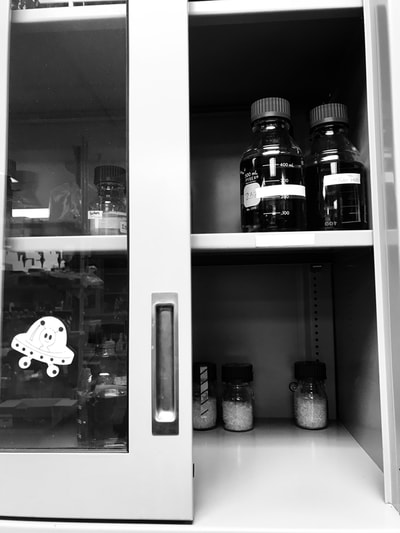RESEARCH
Pathogenic mycobacteria include microbes that cause the human disease, Tuberculosis, and other chronic human infections. Several of the mechanisms used by Mycobacterium tuberculosis to cause disease are shared with environmental bacteria that cause chronic infections. We are interested in understanding the shared molecular mechanisms used by pathogenic mycobacteria to cause disease.
During infection, the mycobacterial pathogens manipulate the host cell to avoid detection by the immune response, and to create a niche that favors replication and persistence. One of the major ways that mycobacterial pathogens manipulate the host is through the secretion of bacterial proteins. The ESX-1 (ESAT-6 System-1) system transports protein virulence factors that are required for mycobacterial pathogenesis. While there are many proteins known to play a role in ESX-1 protein secretion, the way the majority of these proteins function is unclear. Moreover, the pathways regulating the process of proteins secretion are not well understood. We are interested in 1) identifying novel components and substrates of the ESX-1 system, 2) determining how components function to select and transport protein substrates during infection and 3) defining regulatory pathways that regulate protein secretion and connect secretion to adaptation to new environments. 4) defining how proteins are modified and how modification is connected to metabolism.
To do so, we use Mycobacterium marinum and Mycobacterium tuberculosis. M. marinum is a non-tuberculous mycobacterial species (NTM) that is related to M. tb, that causes a tuberculosis-like infection in poikilothermic fish, but rarely causes serious disease in humans. Despite the differences between these two pathogens, the ESX-1 system is functionally conserved. We study the molecular biology of mycobacterial protein secretion using genetic, proteomic and biochemical approaches to better understand mycobacterial pathogenesis. We use both amoebae and macrophage infection models. Understanding the mechanisms used by pathogenic mycobacteria to cause disease will inform future strategies to combat mycobacterial disease, and provide fundamental insight to the process of mycobacterial protein secretion.
RECENT PUBLICATIONS
The genetic proteome: Using genetics to inform the proteome of mycobacterial pathogens.
Nicholson KR, Mousseau CB, Champion MM, Champion PA.PLoS Pathog. 2021 Jan 7;17(1):e1009124. doi: 10.1371/journal.ppat.1009124. eCollection 2021 Jan.PMID: 33411813 Review.
Conserved ESX-1 substrates EspE and EspF are virulence factors that regulate gene expression.
Chirakos AE, Nicholson KR, Huffman A, Champion PA.Infect Immun. 2020 Sep 8:IAI.00289-20. doi: 10.1128/IAI.00289-20. Online ahead of print.PMID: 32900815
Modeling Tubercular ESX-1 Secretion Using Mycobacterium marinum.
Chirakos AE, Balaram A, Conrad W, Champion PA.Microbiol Mol Biol Rev. 2020 Sep 2;84(4):e00082-19. doi: 10.1128/MMBR.00082-19. Print 2020 Nov 18.PMID: 32878966
EspM Is a Conserved Transcription Factor That Regulates Gene Expression in Response to the ESX-1 System. Sanchez KG, Ferrell MJ, Chirakos AE, Nicholson KR, Abramovitch RB, Champion MM, Champion PA.mBio. 2020 Feb 4;11(1):e02807-19. doi: 10.1128/mBio.02807-19.PMID: 32019792
Editorial: Cellular and Molecular Mechanisms of Mycobacterium tuberculosis Virulence.
Sun J, Champion PA, Bigi F.Front Cell Infect Microbiol. 2019 Oct 9;9:331. doi: 10.3389/fcimb.2019.00331. eCollection 2019.PMID: 31649893
A New ESX-1 Substrate in Mycobacterium marinum That Is Required for Hemolysis but Not Host Cell Lysis. Bosserman RE, Nicholson KR, Champion MM, Champion PA. J Bacteriol. 2019 Jun 21;201(14):e00760-18. doi: 10.1128/JB.00760-18. Print 2019 Jul 15.PMID: 30833360
Quantitative N-Terminal Footprinting of Pathogenic Mycobacteria Reveals Differential Protein Acetylation. Thompson CR, Champion MM, Champion PA.J Proteome Res. 2018 Sep 7;17(9):3246-3258. doi: 10.1021/acs.jproteome.8b00373. Epub 2018 Aug 16.PMID: 30080413
Esx Paralogs Are Functionally Equivalent to ESX-1 Proteins but Are Dispensable for Virulence in Mycobacterium marinum.Bosserman RE, Thompson CR, Nicholson KR, Champion PA.J Bacteriol. 2018 May 9;200(11):e00726-17. doi: 10.1128/JB.00726-17. Print 2018 Jun 1.PMID: 29555701
The 24th Annual Midwest Microbial Pathogenesis Meeting.Champion PA, Shrout JD.J Bacteriol. 2018 Feb 26;200(11):e000950-18. doi: 10.1128/JB.00095-18. Online ahead of print.PMID: 29483166
WhiB6 regulation of ESX-1 gene expression is controlled by a negative feedback loop in Mycobacterium marinum. Rachel E. Bosserman, Tiffany T. Nguyen, Kevin G. Sanchez, Alexandra E. Chirakos, Micah J. Ferrell, Cristal R. Thompson, Matthew M. Champion, Robert B. Abramovitch, and Patricia A. Champion. PNAS, 2017; doi:10.1073/pnas.1710167114
Esx Systems and the Mycobacterial Cell Envelope: What's the Connection? Bosserman RE, Champion PA. Journal of Bacteriology. 2017; 199(17). PMID: 28461452
A Nonsense Mutation in Mycobacterium marinum That Is Suppressible by a Novel Mechanism.
Williams EA, Mba Medie F, Bosserman RE, Johnson BK, Reyna C, Ferrell MJ, Champion MM, Abramovitch RB, Champion PA. Infection and Immunity. 2017; 85(2). PMID: 27789543
Rational engineering of a virulence gene from Mycobacterium tuberculosis facilitates proteomic analysis of a natural protein N-terminus. Reyna C, Mba Medie F, Champion MM, Champion PA.
Scientific Reports. 2016; 6:33265. PMID: 27625110
Click here for a complete listing of our publications: https://www.ncbi.nlm.nih.gov/myncbi/patricia.champion.1/bibliography/public/



